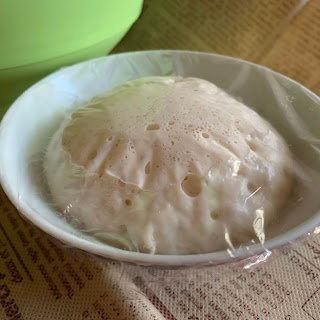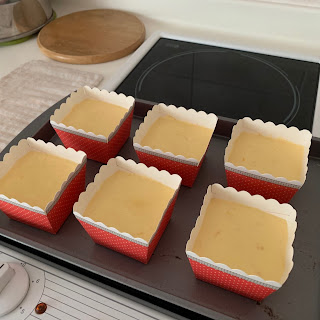I love the sunny colour of the carrot bread, though the flavour of the carrot was not distinct. Milk roux and sponge were used in this recipe to give the bread a soft and springy texture, with a nice aroma. These two extra steps also helped the bread to keep its softness for at least 4 days in room temperature 😊
Yield: 3 loves in a pan
Pan size: Wiltshire enamel coated pan 21x13x6cm
Raw dough weight: 594g
Baking temperature: Preheated oven to 190℃, bake at middle rack at 180℃ for 15 minutes, 170℃ for about 20 minutes.
Most recipes I read used raw carrot instead of cooked carrot. However, I prefer cooked carrot as it gave a closer estimation on the liquid to be added to the dough.
Steamed Carrot Paste
65g carrot, diced
20g water
1. Steam carrot for about 20 minutes, or till softened.
2. Collect about 60g of steamed carrot and blend with 20g of water into a paste.
3. Collect 75g of carrot paste and let it cool down before use.
I prepared the carrot paste one day in advance and kept in the fridge.
Sponge
10g bread flour
2g instant dry yeast
10g water
30g
natural yeast *
* natural yeast can be replaced by 15g each of bread flour and water.
Mix all the ingredients and let it stands for about 60 to 90 minutes.
 Milk Roux
Milk Roux
3g bread flour
2g glutinous rice flour
10g hot water
15g milk
1. Mix and stir over low heat till it thicken into a glossy paste.
2. Cool down and collect about 25g for use later.
Cover with an inverted glass till needed.
Carrot Butter Dough
Ingredients
200g bread flour
80g Prima plain flour plus/plain flour
30g raw cane sugar
4g low-sodium fine salt
6g milk powder
1g pumpkin powder, optional
25g milk roux from above
52g sponge from above
25g beaten egg
75g steamed carrot paste from above
50g fresh milk, cold
20g cold water, added depending on dough condition
30g unsalted butter, added after gluten formed
Toppings
1 tsp bread flour for sprinkling
Directions
1. Mix all the dry ingredients in the mixing bowl of a stand mixer.
2. Add all the wet ingredients, except the 20g of water and unsalted butter, into the mixing bowl. Add the 20g of water slowly to adjust the dough moisture.
When all the ingredients come together into a lump, cover with a lid and keep in the vegetable compartment of a fridge for 20 minutes. This allows autolysis to take place.
 |
| Wet ingredients |
3. Knead the dough at low speed till it form into a smoother dough. Add the softened butter and continue to knead till reaching window pane stage.
4. Transfer the kneaded dough to a mixing bowl coated with a thin layer of oil. Spray some water over, cover and let the dough proof for about 1 hour, or till double in size.
End of 1-hour proofing
5. Invert the dough onto a floured worktop. Deflate and divide into three portions. Shape the dough into three balls, cover and let them rest for 15 minutes.
6. Take a dough and roll flat to about 0.5cm thick. Roll up into a log, cover and and let the dough rest for about 10 minutes.
Roll out the dough into a long dough of about 0.5cm thick again. Roll up like a swissroll and seal at the end.
Lower the dough into the bread pan coated with a thin layer of butter. Spray some water, cover with a tea cloth, and let them proof for about 45 minutes, or till reaching the rim of the pan.
End of 1-hour second proofing
7. Preheat the oven to 190℃. While waiting, dust some bread flour over.
Bake at low rack of a preheated oven at 190℃, lower temperature to 180℃ for 15 minutes, further lower to 170℃ for 15~20 minutes, or till the top has become golden.
7. Transfer the bread out of oven, and remove from pan immediately.
Let the bread rest on a wire rack.
Let the bread cool down completely before cutting. Enjoy 😋







































































